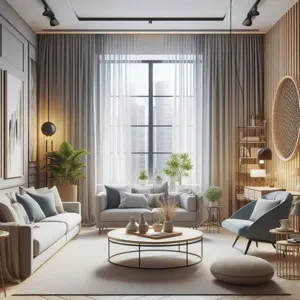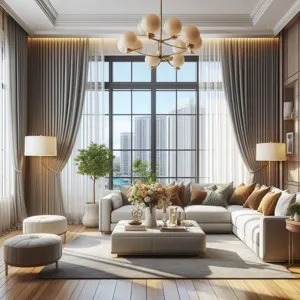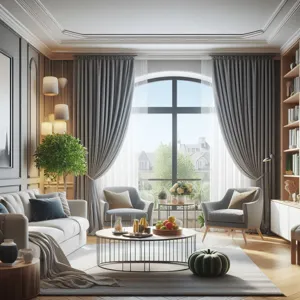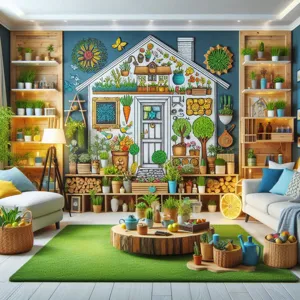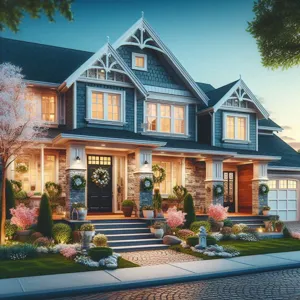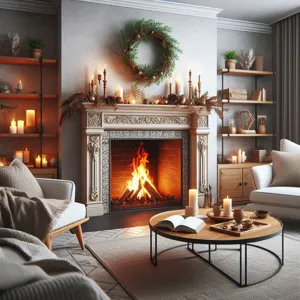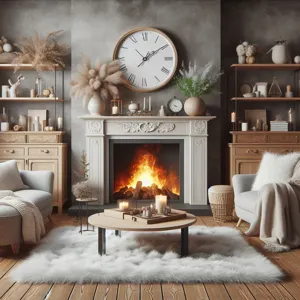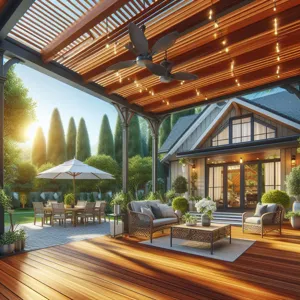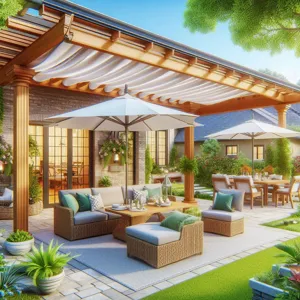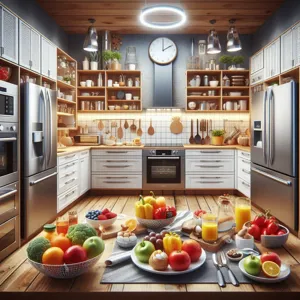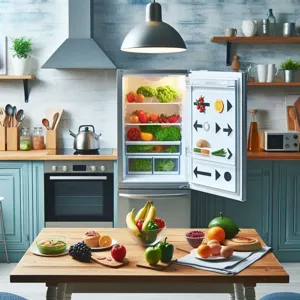Window blinds are more than just functional elements that control light and privacy; they are an essential aspect of your home’s decor that can elevate the ambiance of any room.
With an impressive variety of styles, materials, and features available, choosing the right window blinds can feel overwhelming. Do you want the sleek elegance of wooden blinds, the modern appeal of roller shades, or the classic beauty of Roman shades? Each option not only serves a purpose but also offers its own unique aesthetic and functional benefits. In this comprehensive guide, we will delve into the different types of window blinds, explore their standout features, and provide you with practical tips for selecting the perfect blinds to match your home’s decor and meet your lifestyle needs. Whether you’re redecorating a single room or refreshing your entire home, this guide will help you navigate the world of window blinds with confidence and style.
1. Introduction to Window Blinds: An Overview

When it comes to home decor, window treatments are often an overlooked aspect, yet they play a crucial role in enhancing both the functionality and aesthetic appeal of a space. Window blinds, in particular, are a versatile option that offers a perfect blend of style, privacy, and light control. They come in a wide variety of materials, designs, and mechanisms, making them suitable for any room in the house—from the cozy living room to the more humid kitchen or bathroom.
In this guide, we will delve into the different types of window blinds available on the market today, exploring their unique features and benefits. Whether you’re looking for the sleek finish of aluminum blinds, the warmth of wooden options, or the practicality of vinyl, understanding the distinct characteristics of each type will help you make an informed decision tailored to your needs.
Moreover, we’ll also touch on essential factors to consider when choosing window blinds, including your home’s decor style, the level of light control you desire, and the specific functionality you require. By the end of this comprehensive overview, you’ll be equipped with the knowledge to select the ideal window blinds that not only enhance your home’s interior but also contribute to your comfort and energy efficiency. So, let’s draw the curtains back and explore the world of window blinds!
2. Benefits of Installing Window Blinds
When it comes to enhancing your living space, window blinds are more than just a decorative element; they offer a myriad of benefits that can significantly improve both the functionality and aesthetics of your home.
First and foremost, window blinds provide exceptional light control. Whether you want to bask in natural sunlight during the day or create a cozy, dimly lit atmosphere for the evening, blinds can be easily adjusted to suit your needs. This versatility allows you to create the perfect ambiance in any room, helping to set the mood for relaxation or productivity.
In addition to light control, window blinds also offer privacy. They act as a barrier between your indoor sanctuary and the outside world, allowing you to enjoy your home without the worry of prying eyes. This is particularly beneficial for bedrooms and bathrooms, where privacy is paramount. With a variety of styles available, you can select blinds that offer full coverage or those that allow for some visibility while still maintaining a sense of seclusion.
Energy efficiency is another compelling reason to install window blinds. By effectively blocking out the sun’s rays during the hot summer months and retaining heat during the colder seasons, blinds can help regulate your home’s temperature. This contributes to lower energy bills, as your heating and cooling systems won’t have to work as hard to maintain a comfortable environment.
Moreover, window blinds are available in a wide array of materials, colors, and designs, making it easy to find the perfect match for your interior decor. From sleek aluminum Venetian blinds to elegant wooden plantation shutters, the options are endless. This variety allows you to express your personal style while also enhancing the overall look of your home.
Lastly, installing window blinds can enhance your home’s value. Potential buyers often view well-furnished homes with quality window treatments as more appealing. Investing in blinds can make your space more attractive, giving you a solid return on your investment.
In summary, the benefits of installing window blinds extend far beyond mere aesthetics. With their ability to control light, ensure privacy, enhance energy efficiency, and elevate your home’s design, they are a valuable addition to any living space. Whether you’re redecorating or simply looking to update your window treatments, consider how blinds can transform your home into a more functional and stylish haven.
3. Types of Window Blinds

When it comes to window treatments, the variety of blinds available can be both exciting and overwhelming. Understanding the different types of window blinds is essential for choosing the right style that complements your home’s aesthetics while addressing your functional needs. Here’s a closer look at some of the most popular options:
**1. Vertical Blinds:**
Ideal for large windows and sliding glass doors, vertical blinds feature vertical slats that can be rotated to control light and privacy. They come in various materials, including fabric, vinyl, and aluminum, and are available in a range of colors and patterns, making them a versatile choice for any room.
**2. Horizontal Blinds:**
Often made from wood, faux wood, or aluminum, horizontal blinds are a classic choice for many homes. Their slats are positioned horizontally, allowing for easy light control when tilted. They are particularly suited for smaller windows and are available in different slat sizes, from mini to standard, catering to various design preferences.
**3. Roller Blinds:**
Sleek and minimalistic, roller blinds consist of a single piece of fabric that rolls up and down on a tube. They are available in a wide range of fabrics, from sheer to blackout, making them a perfect option for bedrooms, living rooms, or home offices. Their clean lines can enhance any modern décor.
**4. Roman Blinds:**
For those seeking a touch of elegance, Roman blinds are an excellent choice. Made from soft fabric, these blinds fold neatly when raised, creating a beautiful cascading effect. They come in various styles, including flat and hobbled, and can add warmth and texture to any room.
**5. Cellular (Honeycomb) Blinds:**
Designed with energy efficiency in mind, cellular blinds feature a unique honeycomb structure that traps air, providing insulation and helping to regulate indoor temperatures. They are available in both light-filtering and blackout options, making them a practical choice for multiple rooms in your home.
**6. Pleated Blinds:**
Similar to cellular blinds but without the insulating pockets, pleated blinds are made of a single piece of fabric that is gathered in pleats. They offer a soft, textured appearance and come in a variety of colors and patterns, perfect for adding visual interest to your windows.
**7. Sheer Blinds:**
Combining the benefits of blinds and drapes, sheer blinds feature lightweight fabric layers that allow diffused light to enter while maintaining privacy. They are ideal for living rooms or dining areas where soft, natural light is desired without sacrificing too much visibility.
**8. Faux Wood Blinds:**
For those who love the look of wood but want a more durable and moisture-resistant option, faux wood blinds are the way to go. Made from composite materials, they mimic the appearance of real wood while being easier to clean and maintain, making them a popular choice for kitchens and bathrooms.
When selecting the right type of window blinds for your home, consider factors such as the room’s purpose, the amount of light control needed, and your overall design aesthetic. By understanding the various types of blinds available, you can make an informed decision that enhances both the functionality and beauty of your living spaces.
– 3.1. Venetian Blinds
### 3.1. Venetian Blinds
Venetian blinds are a classic choice that seamlessly combines style and functionality, making them a popular option for homes and offices alike. Characterized by their horizontal slats, typically made from materials such as wood, aluminum, or PVC, these blinds offer exceptional versatility in light control and privacy.
One of the standout features of Venetian blinds is their adjustable slat mechanism, allowing you to tilt the slats to filter light while maintaining privacy. This control enables you to create the perfect ambiance in any room, whether you desire the soft glow of diffused sunlight in a living space or complete darkness for a cozy movie night. The ability to fully raise or lower the blinds adds to their practicality, letting in as much or as little light as you desire.
Venetian blinds come in a variety of materials and finishes, catering to diverse aesthetic preferences. Wooden Venetian blinds exude warmth and elegance, making them ideal for traditional or rustic interiors. On the other hand, aluminum blinds offer a sleek, modern look and are perfect for spaces that require lower maintenance, as they are resistant to warping and fading.
When choosing Venetian blinds for your home, consider the width of the slats as well. Wider slats provide a more contemporary feel and allow for better visibility when tilted, while narrower slats can create a more classic look and offer finer control over light entry. Additionally, various color options and textures allow you to customize the blinds to match your existing decor.
Installation is straightforward, and many homeowners opt for DIY setups, making Venetian blinds not only a stylish choice but also a practical one. With their timeless appeal and functional design, Venetian blinds can enhance any room, providing both visual interest and functional benefits that keep your living space both comfortable and stylish.
– 3.2. Roller Blinds

### 3.2. Roller Blinds
Roller blinds are a popular choice for homeowners seeking a blend of simplicity, functionality, and style. These versatile window coverings consist of a single piece of fabric that rolls up and down along a horizontal tube, allowing for easy operation and a clean aesthetic. Available in an array of colors, patterns, and textures, roller blinds can seamlessly integrate into any room’s decor, enhancing both contemporary and traditional interiors.
One of the standout features of roller blinds is their adaptability. They can be customized to fit any window size, making them suitable for everything from expansive bay windows to petite dormer setups. Moreover, they come in various opacity levels, from sheer materials that gently filter natural light to blackout fabrics that provide complete privacy and darkness—ideal for bedrooms or media rooms.
Functionality extends beyond aesthetics; many roller blinds are equipped with advanced features such as motorization and smart home compatibility. This means you can control your blinds with the touch of a button or even through voice commands, elevating both convenience and luxury in your living space. Additionally, many roller blinds boast energy-efficient properties, helping to regulate indoor temperatures and reduce energy costs throughout the year.
When it comes to installation, roller blinds typically offer a straightforward process, whether you choose to mount them inside or outside the window frame. This flexibility allows homeowners to achieve the perfect fit and finish for their windows. Furthermore, maintenance is a breeze; most fabrics can be wiped clean with a damp cloth, making them a practical choice for busy households.
In summary, roller blinds are an excellent option for anyone looking to enhance their home with a stylish, functional, and adaptable window treatment. With their wide-ranging styles and features, they can meet the diverse needs of any room, ensuring that your space remains both beautiful and comfortable.
– 3.3. Roman Blinds
### 3.3. Roman Blinds
Roman blinds are a timeless window treatment that seamlessly blend elegance with functionality. Known for their soft fabric folds and classic designs, these blinds add a touch of sophistication to any room. Available in a wide array of materials, colors, and patterns, Roman blinds can complement various interior styles, from cozy traditional spaces to sleek modern aesthetics.
One of the standout features of Roman blinds is their ability to filter light while providing privacy. When raised, they stack neatly at the top of the window, allowing for an unobstructed view and maximum sunlight. Conversely, when lowered, they create a soft, warm ambiance, diffusing harsh sunlight and protecting your furnishings from UV damage. This versatility makes them an excellent choice for living rooms, bedrooms, and dining areas alike.
Installation is straightforward, with options for both inside and outside mount, ensuring a perfect fit for any window. Additionally, Roman blinds can be customized with different lining options. A blackout lining is ideal for bedrooms, promoting better sleep by blocking out light completely, while a light-filtering fabric can create a tranquil glow in a sunlit space.
For those interested in sustainability, many manufacturers offer eco-friendly materials, providing a guilt-free way to enhance your home decor. Care and maintenance are also easy, as most Roman blinds can be spot cleaned, ensuring they remain looking fresh and vibrant for years to come.
As you explore your options, consider how Roman blinds can not only enhance the aesthetic appeal of your home but also contribute to your comfort and privacy. With their adaptable style and practical benefits, Roman blinds are a delightful addition to any room, making them a favorite among homeowners and designers alike.
– 3.4. Vertical Blinds
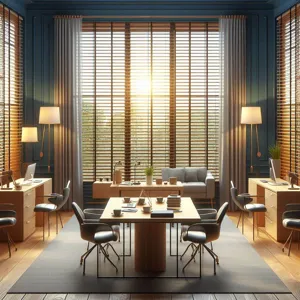
### 3.4. Vertical Blinds
Vertical blinds are a popular choice for both residential and commercial spaces, offering a unique blend of functionality and style. These blinds consist of long, vertical slats that can be adjusted to control light and privacy while also providing a contemporary aesthetic. Typically made from materials such as fabric, vinyl, or aluminum, vertical blinds are versatile and can complement a variety of interior designs, from modern minimalist to traditional decor.
One of the most significant advantages of vertical blinds is their ability to cover large windows and sliding glass doors effectively. The vertical orientation allows for easy operation; you can simply slide the slats to the side to open up your view or tilt them to control the amount of light entering the room. This feature is particularly beneficial in spaces where natural light is abundant, as you can customize the light levels to create the perfect ambiance throughout the day.
In addition to their practical benefits, vertical blinds come in a wide range of colors, patterns, and textures, allowing homeowners to express their personal style. Whether you prefer bold, vibrant hues or soft, neutral tones, there’s a vertical blind option to match your decor. Some variations even incorporate innovative designs, such as sheer vertical blinds, which offer a delicate balance of light diffusion and privacy.
Maintenance is also a key consideration when evaluating vertical blinds. They tend to be easier to clean than horizontal blinds, as dust and debris are less likely to accumulate on the vertical slats. A simple wipe down with a damp cloth is often all that’s needed to keep them looking fresh and new.
When choosing vertical blinds for your home, consider the size of your windows, the amount of light you wish to let in, and the overall decor of your space. With their sleek design and functional benefits, vertical blinds can enhance any room, making them a smart choice for homeowners looking to combine style with practicality.
– 3.5. Cellular Shades
Cellular shades, also known as honeycomb shades, are a popular choice for homeowners seeking both style and energy efficiency. Characterized by their unique design, these shades consist of two or more layers of fabric that form a series of air pockets, resembling a honeycomb structure. This design not only adds an aesthetic appeal to your windows but also serves a functional purpose—providing excellent insulation.
When drawn down, cellular shades trap air within the cells, creating a barrier that helps maintain your home’s temperature. In colder months, they keep warm air from escaping, while in warmer months, they help to block out the heat, potentially lowering your energy bills and enhancing comfort throughout your living spaces.
Available in a variety of colors, patterns, and opacity levels, cellular shades can suit any décor style, from minimalist to traditional. You can opt for sheer fabrics that allow diffused light to filter into your home, or blackout options for complete privacy and light control, making them ideal for bedrooms or media rooms.
Another advantage of cellular shades is their versatility in installation. They can be mounted inside or outside the window frame and are available in top-down/bottom-up configurations, allowing you to customize light control according to your needs. This feature is particularly valuable for those who want to let in natural light while maintaining privacy.
For those concerned about maintenance, cellular shades are relatively easy to clean. Most fabrics can be wiped down with a damp cloth or gently vacuumed, ensuring they remain looking fresh and vibrant. Additionally, many cellular shades come with cordless options, adding a layer of safety for homes with children and pets.
In summary, cellular shades provide an ideal combination of style, energy efficiency, and ease of use, making them an excellent choice for any room in your home. Whether you are looking to enhance your interior design or improve your energy efficiency, cellular shades are definitely worth considering.
– 3.6. Plantation Shutters
### 3.6. Plantation Shutters
Plantation shutters are a timeless and elegant choice that can elevate the aesthetic of any room while providing exceptional functionality. Characterized by their wide slats, usually measuring between 2.5 to 4.5 inches, these shutters offer a classic look that complements a variety of interior styles, from traditional to contemporary. Made from materials such as wood, composite, or vinyl, plantation shutters are as versatile as they are stylish.
One of the standout features of plantation shutters is their ability to control light and privacy with ease. The adjustable slats can be tilted to let in just the right amount of natural light, allowing you to create a warm and inviting atmosphere without sacrificing privacy. This adaptability makes them an excellent choice for rooms that require versatile lighting solutions, such as living rooms, bedrooms, and home offices.
In addition to their aesthetic appeal and light control, plantation shutters are also known for their durability and energy efficiency. Unlike traditional fabric window treatments that may fade or wear over time, well-made plantation shutters can last for years with minimal maintenance. Their solid construction helps insulate windows, keeping your home cooler in the summer and warmer in the winter, which can lead to lower energy bills.
Furthermore, plantation shutters are easy to clean—simply dust them with a soft cloth or use a damp sponge for a deeper clean. This practicality, combined with their elegant appearance, makes them a popular choice among homeowners looking for a long-term window treatment solution.
When considering plantation shutters for your home, think about the color and finish that will best complement your existing decor. Whether you opt for a classic white or a rich wood stain, these shutters can be customized to fit virtually any window shape and size, ensuring a perfect fit that enhances your home’s overall design.
In summary, plantation shutters are not just a window covering; they are an investment in style, functionality, and energy efficiency. Their timeless appeal and practical benefits make them an excellent choice for those looking to enhance their living spaces while enjoying the benefits of superior light control and insulation.
4. Key Features to Consider
When selecting window blinds, it’s essential to consider several key features that impact both functionality and aesthetics. Each feature plays a crucial role in ensuring that the blinds not only enhance your home’s decor but also meet your specific needs.
**1. Material:** The material of the blinds significantly affects their durability, maintenance, and appearance. Common materials include wood, faux wood, vinyl, and fabric. For a warm, classic look, wooden blinds are ideal but require more upkeep. Faux wood offers the same aesthetic with added moisture resistance, making it suitable for high-humidity areas like kitchens and bathrooms. Vinyl blinds are lightweight, easy to clean, and highly durable, while fabric blinds provide a soft, elegant touch but may require more maintenance.
**2. Light Control:** Consider how much light you want to allow into your space. Blinds come with various slat sizes and configurations that offer different levels of light filtration. For instance, sheer blinds allow gentle light to filter through while maintaining privacy, whereas blackout blinds are perfect for bedrooms or media rooms where complete darkness is needed.
**3. Energy Efficiency:** Energy-efficient blinds can help regulate the temperature in your home, potentially lowering your energy bills. Look for options with insulating properties or thermal linings that prevent heat loss in winter and keep spaces cooler in summer. Cellular shades, in particular, are known for their excellent insulation capabilities.
**4. Operation Mechanism:** The way your blinds operate can greatly affect convenience and ease of use. Traditional corded blinds may be familiar, but consider options like cordless, which are safer for children and pets. Motorized blinds offer the ultimate convenience, allowing you to control them with the touch of a button or even via smart home systems, making them an excellent choice for hard-to-reach windows.
**5. Customization Options:** Finally, consider how customizable the blinds are in terms of color, pattern, and size. Custom options allow you to match your blinds perfectly with your interior decor, ensuring they complement the overall design of your home. Whether you prefer bold prints or subtle shades, a wide range of choices is available to suit every taste.
By keeping these key features in mind, you will be well-equipped to choose window blinds that not only enhance your home’s beauty but also provide the functionality you need for your lifestyle.
– 4.1. Material Options
When it comes to selecting window blinds for your home, one of the most crucial factors to consider is the material from which they are made. The right material not only affects the aesthetics of your space but also impacts functionality, durability, and maintenance. Here’s a closer look at the most popular material options available for window blinds, each bringing its own unique benefits and style.
**1. Wood:**
Wood blinds exude timeless elegance and natural beauty, making them a popular choice for many homeowners. Available in various finishes, they can complement a wide range of interior design styles, from rustic to modern. Beyond their aesthetic appeal, wood blinds offer excellent insulation properties, helping to regulate indoor temperatures. However, it’s essential to keep in mind that real wood can be susceptible to warping in high-humidity areas, making them less ideal for kitchens or bathrooms unless properly treated.
**2. Faux Wood:**
For those who love the look of wood but need something more durable and moisture-resistant, faux wood blinds are an excellent alternative. Made from composite materials, these blinds mimic the appearance of real wood while being more resistant to humidity, making them suitable for any room in the house. Faux wood is also often less expensive than real wood, providing a budget-friendly option without sacrificing style.
**3. Vinyl:**
Vinyl blinds are renowned for their practicality and low maintenance requirements. They are incredibly versatile, available in a wide range of colors and styles, and are perfect for high-traffic areas or homes with children and pets. Their non-porous surface makes them resistant to moisture and easy to clean, making them a popular choice for kitchens and bathrooms. However, while vinyl blinds offer great functionality, they may lack the warmth and character of wood or faux wood options.
**4. Fabric:**
Fabric blinds, such as roller shades, Roman shades, or sheer blinds, add a soft and inviting touch to any space. They come in an array of colors, patterns, and textures, allowing for endless customization to match your décor. Fabric blinds can also provide varying degrees of light filtration and privacy, making them suitable for bedrooms, living rooms, and more. However, they typically require more maintenance than other materials, as they can attract dust and may need periodic washing or vacuuming.
**5. Aluminum:**
Aluminum blinds are a sleek and modern choice, often associated with contemporary or minimalist interiors. Lightweight and durable, they are perfect for spaces that require adjustable light control, such as offices or kitchens. Aluminum blinds are resistant to fading and are available in various finishes, including metallic and matte. However, while they offer practical benefits, they may not provide the same warmth and coziness as wooden or fabric options.
When choosing the right material for your window blinds, it’s essential to consider not only your aesthetic preferences but also the specific needs of each room in your home. By understanding the unique characteristics of each material, you can select blinds that enhance your living space, provide functionality, and reflect your personal style.
– 4.2. Light Control and Privacy
When it comes to selecting window blinds, two of the most significant factors to consider are light control and privacy. These elements not only influence the ambiance of a room but also play a crucial role in how comfortable and secure you feel in your space.
**Light Control:** Different types of window blinds offer varying levels of light filtration, allowing you to customize the amount of natural light that enters your home. For instance, sheer shades provide a soft diffusion of sunlight, creating a warm, inviting glow while still offering some level of visibility to the outside world. On the other hand, blackout blinds effectively block out nearly all external light, making them an excellent choice for bedrooms or media rooms where darkness is essential for relaxation or entertainment. For those who want the flexibility to adjust light levels throughout the day, adjustable slatted blinds, such as Venetian or vertical blinds, allow you to tilt the slats for precise control over both light and glare.
**Privacy:** Privacy is paramount in creating a comfortable living environment. Blinds can offer varying degrees of seclusion, depending on the material and design you choose. For instance, roller shades come in different opacities, allowing you to select a fabric that provides either complete coverage or a more translucent option that still maintains your view while keeping prying eyes at bay. Additionally, wood or faux wood blinds lend a classic touch while offering excellent privacy when fully closed. If you live in a densely populated area or have close neighbors, consider options that provide maximum coverage during the evening without sacrificing style.
Ultimately, the ideal window blinds for your home will strike a perfect balance between light control and privacy, reflecting your lifestyle and preferences while enhancing the beauty of your space. As you explore the various styles and functionalities available, keep your specific needs in mind to ensure that your choice contributes to a harmonious and inviting atmosphere.
– 4.3. Energy Efficiency
When it comes to home decor, window blinds do more than just enhance the aesthetic appeal of a room; they also play a crucial role in energy efficiency. In today’s eco-conscious world, homeowners are increasingly aware of how window treatments can contribute to energy savings, helping to reduce both their carbon footprint and utility bills.
Energy-efficient window blinds work by regulating the amount of heat that enters or escapes through your windows, which can significantly impact your home’s temperature. During the scorching summer months, blinds designed with reflective materials can deflect sunlight, keeping your interiors cooler and reducing the need for air conditioning. Conversely, in the winter, insulated blinds help trap warm air inside, preventing chilly drafts from seeping in and allowing you to rely less on heating systems.
When selecting blinds for energy efficiency, consider options such as cellular shades, which feature a honeycomb structure that provides excellent insulation. These shades trap air in their cells, creating a barrier that minimizes heat transfer. Similarly, roller shades with light-filtering materials can help manage glare while still allowing some natural light in, allowing you to enjoy a bright space without overheating.
In addition to the material, the proper installation and fit of your blinds are paramount to their energy-saving capabilities. Blinds that fit snugly within the window frame are more effective at blocking drafts and controlling light compared to those that hang loosely. For maximum efficiency, look for products that are specifically labeled as energy-efficient or that have received certifications, such as the ENERGY STAR rating.
Ultimately, choosing energy-efficient window blinds not only enhances your home’s comfort but also contributes to long-term savings and a more sustainable lifestyle. By carefully considering the types of blinds available and their insulating properties, you can make a choice that benefits both your home and the environment.
– 4.4. Style and Aesthetics
When it comes to window blinds, style and aesthetics play a pivotal role in enhancing the overall ambiance of your home. Beyond their functional purpose of controlling light and privacy, blinds are also an essential design element that can tie together your room’s decor and reflect your personal taste.
Consider the color palette and design of your space when selecting blinds. A minimalist, modern living room may benefit from sleek, neutral-colored roller blinds that blend seamlessly with the walls. In contrast, a bohemian bedroom could be beautifully complemented by vibrant, patterned Roman blinds that add a touch of whimsy and charm.
Material choice is another crucial aspect of style. Wooden blinds offer a classic, warm aesthetic that can evoke a sense of coziness, while aluminum or vinyl options provide a more contemporary, polished look. Textured fabrics can introduce depth and interest, making your windows a focal point in the room.
Furthermore, think about the shape and size of your windows. Custom-made blinds can ensure a perfect fit, allowing for a more tailored appearance that enhances your home’s architectural features. Layering different types of blinds—such as sheer shades underneath thicker blackout curtains—can create a sophisticated look while providing versatility in light control.
Ultimately, the right window blinds should not only complement your existing decor but also express your unique style. By carefully considering the aesthetics of your blinds alongside their functionality, you can create a harmonious atmosphere that elevates your living space.
– 4.5. Ease of Operation
When selecting window blinds for your home, ease of operation is a crucial factor that can significantly influence your overall satisfaction. After all, the primary purpose of blinds is not just to enhance privacy and aesthetics, but also to provide convenience in managing light and ventilation. Consider how you will interact with your blinds daily.
For those who prefer simplicity, traditional corded blinds may suffice, but they can sometimes be cumbersome and pose a safety risk, especially in households with young children or pets. In contrast, cordless options are an excellent choice for ease and safety; they feature a clean, streamlined look and allow you to effortlessly raise or lower the blinds with a gentle push or pull.
For the tech-savvy homeowner, motorized blinds offer the ultimate in convenience. With the touch of a button or a simple voice command through smart home devices, you can adjust your blinds from anywhere in the room—or even remotely. This feature not only adds a layer of luxury but also enhances energy efficiency by enabling you to control sunlight and heat without having to physically adjust the blinds.
When evaluating ease of operation, also consider the weight and materials of the blinds. Lighter materials tend to be easier to handle, while heavier ones may require more effort to operate, particularly on larger windows.
Ultimately, the right choice will depend on your lifestyle and preferences. Whether you opt for classic corded blinds, a safe and sleek cordless design, or the cutting-edge convenience of motorized options, ensuring your window treatments are easy to operate will enhance your daily routine and elevate your living space.
5. Measuring Your Windows for Blinds
Measuring your windows accurately is a crucial step in ensuring a perfect fit for your new blinds. An ill-fitting blind can not only detract from the aesthetic of your space but can also compromise functionality. To get started, gather your tools — a metal tape measure, a pencil, and a notepad are all you need to take precise measurements.
Begin by determining whether you want to install your blinds inside the window frame for a clean, streamlined look or outside the frame for a bolder statement. For inside mounts, carefully measure the width and height of your window at three different points: the top, middle, and bottom for width, and the left, center, and right for height. This helps account for any irregularities in your window’s dimensions. Record the smallest measurement for both width and height, as this will be your guide for ordering.
For outside mounts, measure the width and height of the entire area you want to cover. Be sure to add extra inches to both dimensions to allow for light control and to ensure complete coverage of the window. Generally, adding 1 to 3 inches on each side is recommended for width, while additional height can enhance the visual impact.
Once you’ve taken your measurements, double-check them to avoid any costly mistakes. If you’re unsure or uncomfortable with the process, many retailers offer professional measuring services to guarantee accuracy. Remember, precise measurements are the foundation for choosing the right blinds that enhance both the beauty and functionality of your space. With accurate dimensions in hand, you’ll be one step closer to transforming your windows into stunning focal points that reflect your personal style.
6. Choosing the Right Color and Pattern
When it comes to selecting the right color and pattern for your window blinds, the choices can seem endless, but this decision is crucial in defining the mood and aesthetic of your space. The right blinds can enhance your interior design, create a harmonious atmosphere, and even impact the overall light and temperature of the room.
Start by considering the existing color palette of the room. If you have bold or vibrant wall colors, you might want to opt for a neutral shade for your blinds to create balance and allow the walls to shine. Soft whites, grays, or beiges can serve as a perfect backdrop, allowing you the freedom to add colorful accessories without overwhelming the senses. On the other hand, if your walls are more muted, feel free to explore bolder patterns or darker colors to make a striking statement.
Patterns also play a significant role in setting the tone of your space. Geometric patterns can lend a modern and sophisticated look, while floral designs could add a touch of warmth and charm. Striped blinds can draw the eye upward, making a room feel taller, while larger prints can create a lively focal point. Think about the mood you want to convey: soft and inviting, sleek and contemporary, or eclectic and fun.
Additionally, consider the functionality of the blinds. If privacy and light control are top priorities, darker, solid colors may work best, as they can block light more effectively. If you’re looking to create an airy, light-filled space, translucent or light-colored blinds can allow soft natural light to filter through while maintaining a sense of openness.
Ultimately, choosing the right color and pattern should not just be about aesthetics but also about how the blinds will fit into your lifestyle. Take samples home to see how they look in different lighting throughout the day, and don’t hesitate to consult with design professionals who can provide insights tailored to your unique space. With the right color and pattern, your window blinds can transform your home into a beautifully cohesive sanctuary.
7. Installation Process: DIY vs. Professional Help
When it comes to installing window blinds, one of the first decisions you’ll need to make is whether to tackle the project yourself or enlist the help of a professional. Each option comes with its own set of advantages and challenges, so let’s break it down to help you make an informed choice.
**DIY Installation: A Hands-On Approach**
For those who love a good weekend project or enjoy the satisfaction of a job well done, DIY installation can be a rewarding experience. Most window blinds come with detailed instructions and all the necessary hardware, making it accessible even for novice DIYers. With some basic tools—like a drill, measuring tape, and level—you can save on installation costs while customizing the fit and placement to your exact preferences.
However, DIY installation requires careful attention to detail. Proper measurements are crucial; an error here can lead to blinds that are too short, too long, or misaligned. Additionally, the process can be time-consuming, especially if you’re installing multiple blinds. Patience and precision are key, but the sense of accomplishment when you pull that cord for the first time is truly unmatched.
**Professional Installation: Expertise at Your Service**
On the other hand, hiring a professional can alleviate the stress that comes with the installation process. Professionals have the experience and tools needed to ensure your window blinds are installed correctly and efficiently. They can address any unique challenges that might arise, such as tricky window shapes or unusual mounting conditions, providing a seamless finish that enhances your home’s aesthetic.
Moreover, many professional services offer guarantees or warranties on their work, giving you peace of mind that the job will be done right. While this option will incur an additional cost, the investment might be worth it for those who prefer a hassle-free experience or lack the time and tools to do it themselves.
**Making the Decision: What’s Right for You?**
Ultimately, the choice between DIY installation and professional help depends on your comfort level with home improvement projects, your budget, and the complexity of the installation. If you’re confident in your skills and enjoy working with your hands, a DIY approach can be both fun and cost-effective. However, if you prefer to leave it to the experts, hiring a professional can ensure your window blinds are installed with precision and care.
Consider your priorities, assess your skills, and choose the option that best fits your lifestyle and home improvement goals. No matter which route you choose, the end result will be beautifully functional window blinds that enhance your living space.
8. Maintenance and Care for Window Blinds
### 8. Maintenance and Care for Window Blinds
Caring for your window blinds is essential not only for their longevity but also for maintaining the aesthetic appeal of your home. Proper maintenance can help prevent dust and dirt buildup, keeping your blinds looking fresh and vibrant. Here are some key tips for maintaining various types of window blinds:
**1. Dust Regularly:**
For most blinds, a simple weekly dusting with a microfiber cloth or a duster will suffice. This is particularly important for horizontal blinds, where dust tends to accumulate on the slats. For vertical blinds, a gentle swipe from top to bottom will keep them looking pristine.
**2. Deep Cleaning:**
Depending on the material, your blinds will have different cleaning requirements. For faux wood or vinyl blinds, a damp cloth with mild detergent can remove stubborn stains. For fabric blinds, vacuuming with a brush attachment can help remove dust, but be sure to check the manufacturer’s instructions regarding washing. Some may be machine washable, while others require spot cleaning.
**3. Avoid Excessive Moisture:**
If you have wooden blinds, it’s crucial to keep them away from excessive moisture, which can cause warping or damage. In areas with high humidity, such as kitchens or bathrooms, consider using synthetic materials that can withstand these conditions.
**4. Repair and Replace:**
Inspect your blinds regularly for any signs of wear and tear. If a slat is bent or a mechanism is malfunctioning, address the issue promptly. Many blinds can be repaired with replacement parts, which can be more cost-effective than a full replacement.
**5. Seasonal Checks:**
As seasons change, so do the environmental factors that can affect your blinds. In winter, for instance, ensure that your blinds aren’t obstructing heating vents, and in summer, clean them more frequently to remove pollen and dust. Adjusting your cleaning routine according to seasonal needs can preserve the integrity and appearance of your blinds.
By integrating these maintenance tips into your routine, you’ll not only enhance the lifespan of your window blinds but also enjoy their beauty and functionality for years to come. Remember, well-maintained blinds contribute significantly to your home’s overall ambiance, ensuring that they remain a stylish and practical addition to your space.
9. Common Mistakes to Avoid When Choosing Blinds
When it comes to selecting the perfect window blinds for your home, avoiding common pitfalls can make all the difference between a well-finished look and a design disaster. Here are some frequent mistakes to steer clear of as you embark on your journey to find the ideal window treatments.
**1. Ignoring Measurements:** One of the most critical steps in the blinds selection process is accurate measurement. Many homeowners rush this part, leading to ill-fitting blinds that either leave gaps or are too tight. Always measure your windows carefully, considering both width and height, and remember to account for any obstructions like handles or moldings. If in doubt, consult a professional or use online measurement guides to ensure a perfect fit.
**2. Overlooking Functionality:** While aesthetics are essential, it’s equally important to consider how you will use the blinds. Are you looking for maximum light control, privacy, or insulation? For instance, sheer blinds can beautifully diffuse natural light but may not provide the privacy you need at night. Evaluate the function you want them to serve and choose accordingly.
**3. Disregarding Material and Maintenance:** The material you choose for your blinds can significantly influence their longevity and upkeep. Wooden blinds offer warmth and elegance but require more maintenance than vinyl or fabric options, which are often easier to clean and more resistant to moisture. Consider your lifestyle and the specific needs of each room—high-humidity areas like kitchens and bathrooms may require more durable materials.
**4. Matching Everything:** While coordinating your blinds with your interior decor is important, overly matching can create a monotonous look. Instead of opting for blinds that are an exact match to your wall color or furniture, consider introducing complementary shades or textures. This adds depth and visual interest to your space, making it feel more dynamic and inviting.
**5. Skipping the Sample Phase:** Don’t make the mistake of choosing your blinds based solely on online images or showroom displays. Colors and textures can vary drastically under different lighting conditions. Always request samples or swatches to see how they look in your home’s natural light at various times of the day. This can help you avoid the disappointment of a color that doesn’t translate well once installed.
**6. Neglecting to Think Long-Term:** Lastly, it’s easy to get caught up in trends, but remember to consider the longevity of your choice. While bold patterns or trendy colors may be appealing now, they might not be in a few years. Opt for timeless designs and colors that will continue to complement your home as styles evolve.
By being aware of these common mistakes, you can make more informed decisions, ensuring that your choice of window blinds enhances your home’s aesthetic while providing the functionality you need. Take your time, do your research, and you’ll find the perfect fit that keeps your spaces stylish and inviting for years to come.
10. Budgeting for Window Blinds: What to Expect
When it comes to outfitting your home with the perfect window blinds, understanding your budget is crucial to making an informed decision. The cost of window blinds can vary significantly based on several factors, including the type, material, size, and brand.
On the more economical end, basic roller blinds or simple fabric shades can start as low as $20 to $50 per window. These options are functional and can provide a decent level of privacy and light control without breaking the bank. However, if you’re looking for something more aesthetically pleasing or durable, prices can escalate quickly. Custom-made options, such as wooden blinds or intricate Roman shades, can run anywhere from $100 to $300 or more per window depending on the specifications.
It’s also important to factor in installation costs, particularly for complex setups or larger windows. While many blinds can be installed DIY-style with some basic tools and a bit of patience, hiring a professional can range from $50 to $150, depending on the complexity of the installation.
Additionally, consider the long-term investment aspects of your choices. Higher-quality materials may come with a larger upfront cost but often provide better durability and energy efficiency, ultimately saving you money on heating and cooling costs in the long run.
Lastly, it’s wise to keep an eye out for seasonal sales or promotions, as many retailers offer significant discounts during holiday seasons or clearance events. By planning ahead and understanding the various elements that contribute to the overall cost, you can confidently choose window blinds that not only fit your budget but also enhance the beauty and functionality of your home.
11. Eco-Friendly Options for Sustainable Living
As the world increasingly prioritizes sustainability, eco-friendly window blinds have emerged as a popular choice for environmentally conscious homeowners. These blinds not only enhance the aesthetic appeal of your space but also contribute positively to the planet. When considering eco-friendly options, look for materials that are either renewable, recycled, or sustainably sourced.
One of the most popular eco-friendly materials is bamboo, known for its rapid growth and minimal environmental impact. Bamboo blinds offer a beautiful, natural look while providing excellent light control and insulation. Similarly, shades made from organic cotton or linen are another sustainable choice, providing a soft, inviting texture without chemical treatments that can be harmful to both your health and the environment.
Another option to consider is cellular shades, which are designed to trap air and improve your home’s energy efficiency. Many manufacturers now produce cellular shades using recycled materials, allowing you to enjoy their insulating benefits while also supporting sustainability efforts. Additionally, look for blinds with low-VOC (volatile organic compounds) finishes, as these contribute to better indoor air quality.
When selecting eco-friendly blinds, consider the lifecycle of the product. Opt for those that are durable and made to last, reducing the need for replacements over time. Many brands offer warranties, which is a testament to their commitment to quality and sustainability.
By choosing eco-friendly window blinds, you’re not only making a stylish addition to your home but also taking a step toward sustainable living. These options can significantly reduce your carbon footprint while creating a healthier living environment for you and your family. Remember, every small choice can contribute to a larger change, and your window treatments are a perfect place to start.
12. Trends in Window Blinds: What’s Popular Now
As we step into a new era of interior design, window blinds have evolved beyond mere functional elements into stylish statements that enhance the overall aesthetic of our living spaces. Today, homeowners are increasingly opting for window treatments that not only provide privacy and light control but also contribute to the design narrative of their rooms. Here are some of the most popular trends in window blinds that are captivating homeowners in 2023.
### Natural Materials
One of the most significant trends is the shift towards eco-friendly, natural materials. Bamboo and wood blinds are making a strong comeback, celebrated for their warmth and organic appeal. These materials not only bring a touch of nature indoors but also help create a calming atmosphere. Homeowners appreciate the sustainability aspect, as well as the unique textures and hues that natural blinds provide.
### Smart Technology
In a world that’s becoming increasingly connected, smart window blinds are at the forefront of modernization. These innovative treatments can be controlled via smartphones or smart home systems, allowing for effortless adjustments of light and privacy at the touch of a button. From automated schedules to voice commands, the convenience of smart blinds is appealing to tech-savvy homeowners looking to enhance their living spaces while maximizing energy efficiency.
### Bold Patterns and Colors
Gone are the days of plain, neutral window treatments. This year, bold patterns and vibrant colors are taking center stage. Designers are encouraging homeowners to experiment with geometric prints, florals, and rich tones that add personality and flair to any room. Whether it’s a striking Roman shade in a jewel tone or roller blinds adorned with an eye-catching design, these choices can transform a mundane window into a focal point.
### Layering Treatments
Layering is another trend that’s gaining traction. Mixing and matching different types of blinds, such as pairing sheer roller shades with heavy drapes, allows for greater flexibility in controlling light and privacy. This approach not only enhances functionality but also adds depth and dimension to windows, creating a more curated and polished look.
### Minimalist Designs
On the opposite end of the spectrum, minimalist designs continue to resonate with many homeowners. Sleek, simple blinds that offer clean lines and subtle elegance are favored in modern and contemporary spaces. These designs often feature neutral colors and uncomplicated mechanisms that promote a clutter-free aesthetic, aligning perfectly with the principles of minimalism.
### Sustainability and Energy Efficiency
More homeowners are becoming conscious of their environmental impact, leading to a rise in demand for sustainable and energy-efficient window blinds. Options like thermal blinds that help regulate indoor temperatures and reduce energy costs are particularly popular. Additionally, many brands are now offering blinds made from recycled materials, combining style with eco-friendly practices.
In conclusion, the world of window blinds in 2023 is characterized by a blend of innovation, sustainability, and artistic expression. By staying informed about these trends, you can select window treatments that not only suit your functional needs but also elevate the overall ambiance of your home. Whether you prefer the warmth of natural materials, the convenience of smart technology, or the allure of bold designs, the perfect set of window blinds awaits to transform your space.
13. Conclusion: Finding the Perfect Window Blinds for Your Home
In conclusion, finding the perfect window blinds for your home is not just about aesthetics; it’s about enhancing your living space in a way that aligns with your lifestyle, preferences, and functional needs. With a plethora of options available—from classic wooden blinds to sleek roller shades and versatile cellular shades—there’s a style to suit every taste and requirement.
Consider the atmosphere you wish to create in each room: warm and inviting, modern and minimalist, or perhaps a blend of both. Think about the practical aspects, such as light control, privacy, and insulation, which are essential for comfort and energy efficiency. Don’t forget to factor in the maintenance and durability of the materials you choose, ensuring they can withstand daily wear while still looking fabulous.
As you embark on this journey of selecting window blinds, take the time to measure your windows accurately and explore the various features that each type offers. Whether you prefer the ease of a motorized option or the timeless charm of manual controls, the right choice will enhance your home’s functionality while reflecting your personal style.
Ultimately, the perfect window blinds will not only elevate your home’s décor but also create a sanctuary that caters to your unique needs. With careful consideration and a bit of research, you’ll find the ideal window treatment that balances beauty, practicality, and comfort, making your living space truly your own. Happy decorating!
14. Additional Resources and FAQs
As you embark on the journey of selecting the perfect window blinds for your home, having access to reliable resources and answers to common questions can greatly enhance your decision-making process. Below, we’ve compiled a list of additional resources and frequently asked questions to provide you with a comprehensive understanding of window blinds and help you make the best choice for your space.
### Additional Resources
1. **Online Design Tools**: Many home improvement websites offer interactive design tools that allow you to visualize different styles and colors of blinds in your space. Websites like Houzz or Pinterest can also inspire you with various design ideas and the latest trends in window treatments.
2. **Manufacturer Guides**: Reputable manufacturers often provide detailed guides on their websites that cover everything from installation instructions to maintenance tips. These guides can help you understand the specific features and benefits of the blinds you are considering.
3. **Home Decor Blogs**: Explore blogs dedicated to home decor and interior design, where experts share insights on choosing the right window treatments. These blogs often feature reviews, comparisons, and style tips to help you navigate your options.
4. **YouTube Tutorials**: Visual learners will appreciate the plethora of video tutorials available on platforms like YouTube, where you can watch step-by-step guides on measuring, installing, and even customizing your window blinds.
### Frequently Asked Questions
**Q: What are the best types of blinds for light control?**
A: For maximum light control, consider blackout roller shades or cellular shades. These options allow you to completely block out light when needed, ideal for bedrooms or media rooms.
**Q: How do I measure my windows for blinds?**
A: Start by measuring the width and height of your window frame. For inside mounts, subtract about 1/4 inch from both measurements to ensure a snug fit. For outside mounts, add a few inches to each measurement for better light coverage and aesthetic appeal.
**Q: Are there energy-efficient options for window blinds?**
A: Yes! Cellular shades are known for their energy efficiency due to their honeycomb structure that traps air, providing insulation. Additionally, some blinds come with reflective coatings that can help reduce heat gain in summer and heat loss in winter.
**Q: How can I maintain my blinds?**
A: Regular dusting with a soft cloth or a vacuum with a brush attachment is usually sufficient. For deeper cleaning, follow the manufacturer’s instructions, as some materials can be wiped down with a damp cloth while others may need special care.
With these resources and answers at your fingertips, you can confidently explore the world of window blinds, ensuring you select the perfect style that complements your home while meeting your functional needs. Whether you’re seeking aesthetic appeal, light control, or energy efficiency, the right blinds can transform your windows and enhance the overall ambiance of your living space.
In conclusion, we hope this comprehensive guide to window blinds has equipped you with the knowledge and confidence needed to make an informed decision for your home. With a multitude of types and features to choose from, selecting the perfect window treatment can significantly enhance both the aesthetics and functionality of your living space. Whether you opt for the sleek elegance of roller blinds, the classic charm of wooden shutters, or the versatility of vertical blinds, the right choice can transform your environment while providing privacy, light control, and energy efficiency. Remember to consider your personal style, the specific needs of each room, and your budget as you navigate this exciting home improvement journey. We encourage you to take the next step and explore your options, envisioning how the right window blinds can elevate your home’s comfort and beauty. Happy decorating!

